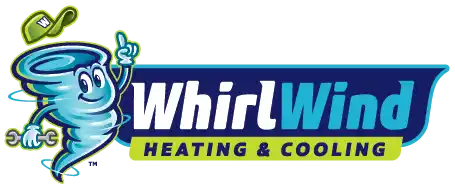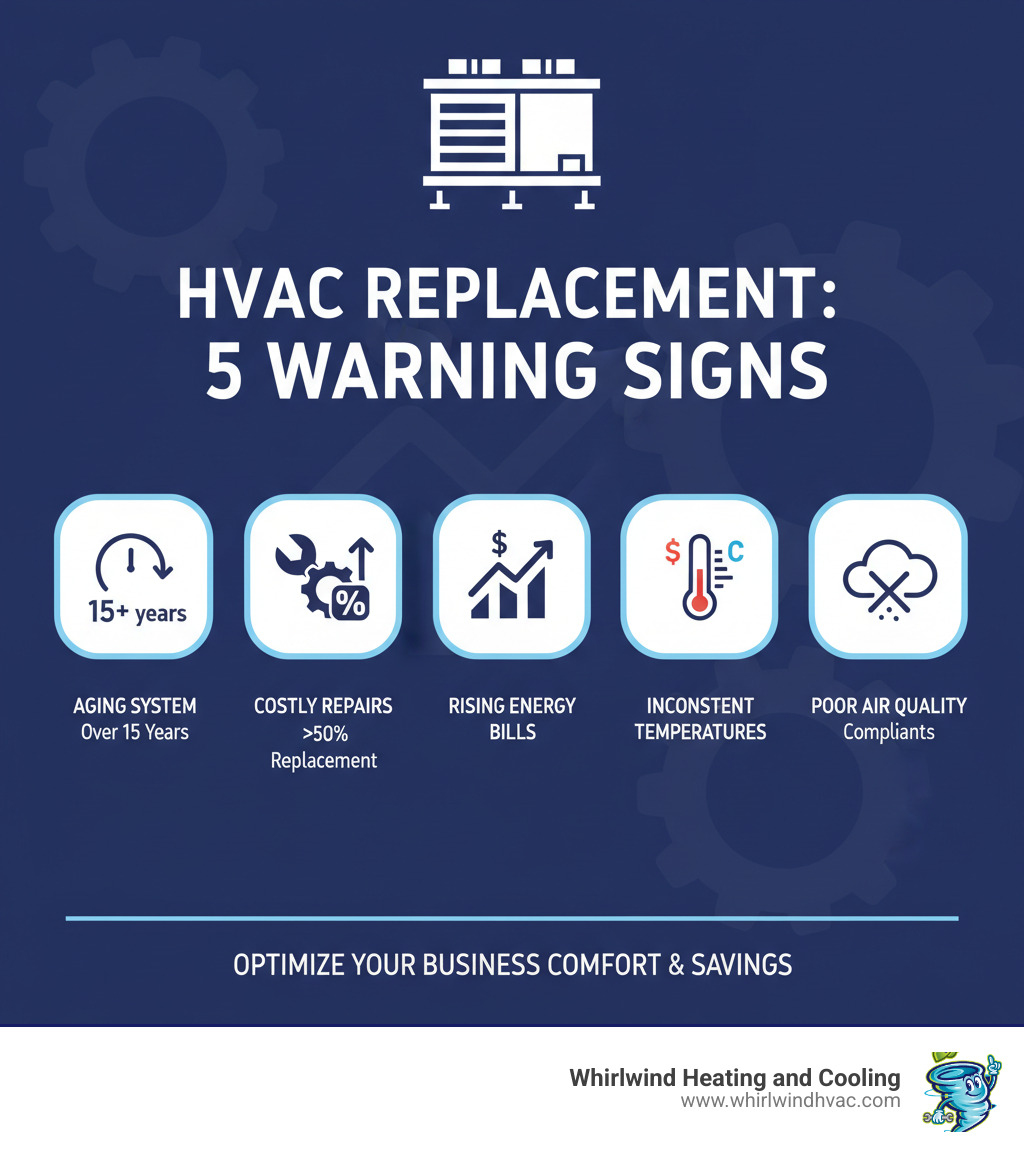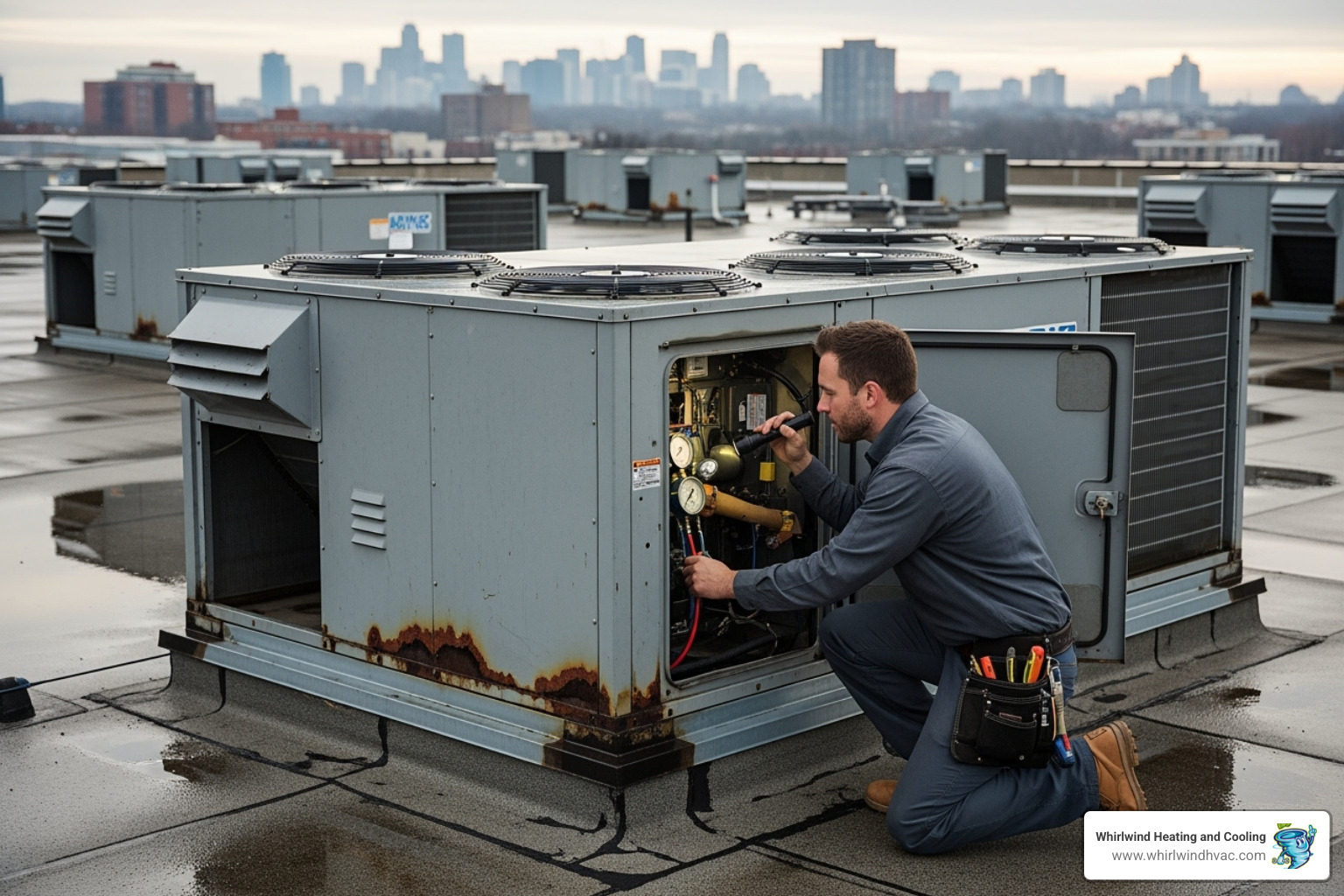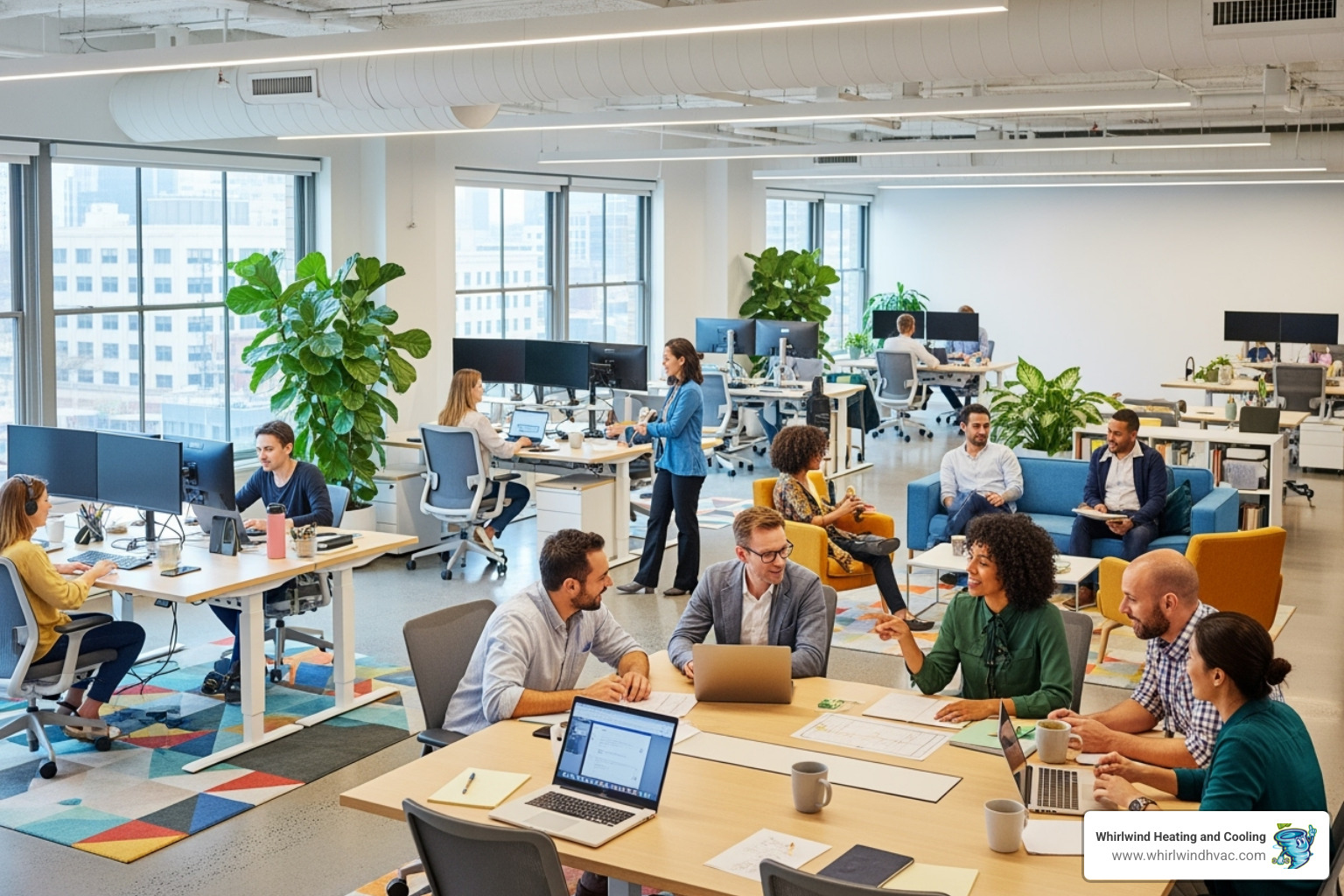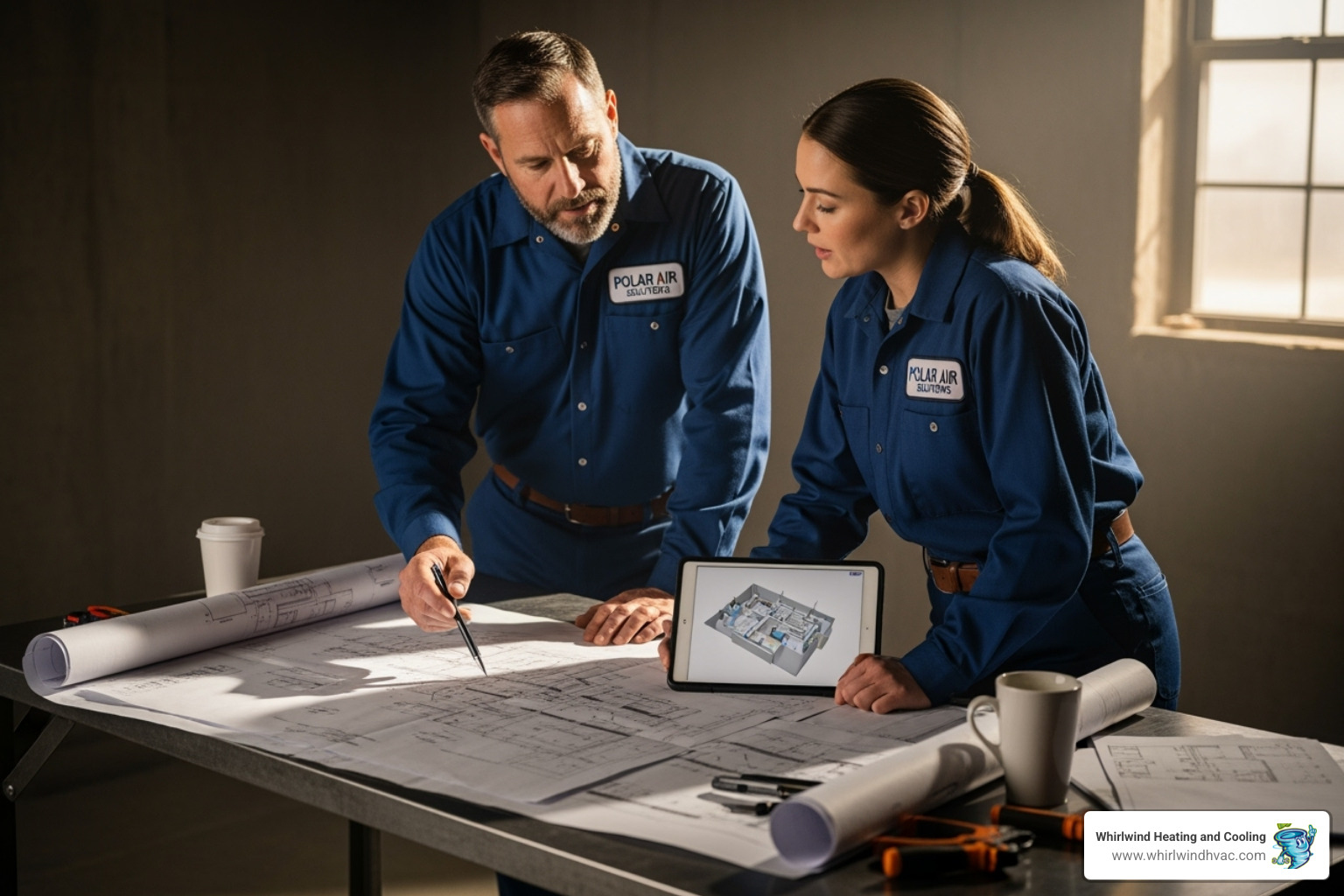Is Your HVAC System an Asset or a Liability?
Commercial HVAC replacement becomes necessary when your system transforms from a reliable asset into a costly liability. Business owners often face this decision when mounting repair bills, high energy costs, and employee comfort complaints signal it’s time for a change.
Key indicators your commercial HVAC needs replacement:
- System age: 15-20 years old
- Frequent breakdowns: Repairs happening monthly or quarterly
- Rising energy bills: 20%+ increase without usage changes
- Temperature inconsistencies: Hot and cold spots throughout the building
- Poor air quality: Employee complaints about stuffiness or allergens
- Obsolete refrigerant: R-22 systems facing phase-out costs
When your HVAC unit struggles or your energy bills skyrocket, it’s a clear sign your system is failing. The median cost for commercial HVAC replacement is typically $10,000 to $50,000, but this investment can slash energy use by up to 50%.
The business impact goes beyond comfort. Employee productivity can improve by 10% with proper air quality and temperature control. Modern HVAC systems also help prevent sick building syndrome, which costs U.S. businesses billions annually, through advanced filtration and ventilation.
Smart business owners know that commercial HVAC replacement isn’t just a fix—it’s a strategic investment that reduces operating costs, improves workplace conditions, and can increase property value by up to 7%.
When to Repair vs. Replace: Key Indicators for Your Commercial System
Deciding whether to repair or replace your commercial HVAC system can be tough. If you’re facing another large repair bill and wondering if you’re throwing good money after bad, it might be time to consider a replacement.
The key is recognizing when your system becomes a money pit. Here are the main indicators:
- System Age: Once a unit hits the 15-20 year mark, it’s in decline. An aging HVAC system might still run, but it will cost you more in energy and repairs.
- Rising Energy Costs: If your bills are creeping up without a change in usage, your system is working harder and less efficiently. Efficiency drops significantly after 10-15 years.
- Frequent and Costly Repairs: If you’re calling for repairs regularly, your system is signaling that it’s failing. You’re likely caught in an expensive cycle of temporary fixes.
- Inconsistent Temperatures: Hot and cold spots mean your system is struggling to distribute air properly, pointing to failing components or an improperly sized unit.
- Poor Indoor Air Quality: Employee complaints about stuffiness, odors, or allergies indicate failing filtration and ventilation. Modern units offer advanced filtration that older systems lack.
- Obsolete Refrigerant: Systems using R-22 face a ticking time bomb of high repair costs, as the refrigerant is phased out and becomes expensive and scarce. This alone can justify commercial HVAC replacement.
Understanding What Preventive Maintenance on Your HVAC System Involves can extend your system’s life, but it can’t stop the effects of age.
The 50% Rule for Repairs
A simple guideline: if a repair costs 50% or more of a new system’s price, it’s time to replace. This rule accounts for the likelihood of future repairs, the system’s remaining lifespan, and the energy savings a new model provides. Pouring money into a failing system is rarely a good investment. Today’s repair might only buy you a few months of service before the next problem arises. When Furnace Replacement is Necessary explores this decision in more detail.
Age and Inefficiency
Commercial HVAC systems are built to last 15-20 years, but their performance declines with age. A 10-15 year old unit consumes more energy than a modern one. Technology has advanced significantly, with today’s systems offering variable-speed compressors, smart controls, and higher SEER ratings. This efficiency degradation in older systems continuously drains your energy budget. The U.S. Department of Energy states that upgrading can cut heating and cooling energy use by up to 50%. Before your utility bills become unmanageable, explore When to Consider Furnace Replacement to understand your options.
The ROI of Upgrading: Benefits Beyond Basic Comfort
Upgrading your commercial HVAC system is one of the smartest investments you can make, with benefits that extend far beyond fixing an immediate problem. A new system delivers significant returns through energy savings, improved air quality, boosted productivity, increased property value, and reduced maintenance costs.
While an old system drains resources, a new, efficient one becomes a profit center that pays for itself through lower operating costs and a healthier, more productive workforce.
Slashing Operational Costs with Energy Efficiency
This is where commercial HVAC replacement truly shines. Modern high-efficiency equipment can cut your heating and cooling energy use by up to 50%. For example, upgrading from an old 8 SEER unit to a modern 16 SEER unit can cut your cooling costs in half. SEER (Seasonal Energy Efficiency Ratio) measures cooling output per dollar of electricity—higher SEER ratings mean lower utility bills.
Variable speed technology adds to these savings by matching the system’s output to your building’s precise needs, rather than running at full blast. The Energy savings from variable speed technology are substantial in commercial settings. Likewise, modern heating technology offers significant energy savings, and the Benefits of Heater Installation add up over the system’s 15-20 year lifespan.
Improving Indoor Air Quality (IAQ) and Productivity
A new HVAC system actively improves the air your employees breathe. Modern systems support advanced filtration (MERV-13+) that captures fine dust, pollen, and airborne pathogens that older filters miss. They also feature better ventilation strategies, using smart controls to bring in fresh air and remove stale air.
This directly impacts your bottom line. Employee productivity can improve by up to 10% in environments with proper air quality and temperature control. Conversely, poor IAQ contributes to “sick building syndrome,” costing U.S. businesses billions annually. Modern systems also provide better humidity control, preventing mold growth and creating a more comfortable environment. When your employees feel better, they work better, and your business thrives.
The Roadmap for a Successful Commercial HVAC Replacement
Planning a commercial HVAC replacement is a straightforward process with the right partner. At Whirlwind Heating and Cooling, we guide businesses throughout the Willamette Valley through a clear, three-phase roadmap to eliminate surprises and ensure long-term savings.
Every successful project includes a professional assessment, selecting the right system, and expert installation and commissioning. This ensures your new system is a perfect fit for your building, budget, and goals.
Step 1: Professional Assessment and Load Calculation
Before recommending a system, we conduct a comprehensive evaluation to determine your building’s specific heating and cooling needs. We analyze:
- Building Size and Layout: We assess square footage and airflow to identify potential problem areas.
- Occupancy Levels: The number of people generates significant heat, so we account for peak occupancy to ensure your system can handle the load.
- Local Climate: Our expertise in the Willamette Valley climate means your system will be tuned for our mild, wet winters and warm, dry summers.
- Insulation and Windows: The quality of your building’s envelope determines how hard your system must work.
- Heat-Generating Equipment: We account for internal heat sources like server rooms or commercial kitchens.
Accurate sizing is crucial. An undersized system struggles to keep up, while an oversized one wastes energy and wears out faster. Proper sizing can reduce upfront and annual costs by 15-25%.
Step 2: Choosing the Right System Type
With a clear understanding of your needs, we help you select the best type of commercial HVAC system:
- Rooftop Units (RTUs): These all-in-one workhorses are ideal for small to medium-sized businesses, offering reliable performance while saving indoor space.
- Variable Refrigerant Flow (VRF) Systems: The cutting edge of efficiency, VRF systems provide zoned temperature control, perfect for buildings with varied usage like multi-tenant offices.
- Chillers: Best for large commercial buildings like hospitals and universities, these systems use chilled water for highly efficient cooling at scale.
- Ductless Mini-Splits: Offering great flexibility, these are excellent for buildings without ductwork or for targeting specific hot or cold spots in offices or retail spaces.
We’ll help you weigh your budget, energy goals, and operational needs to find the perfect match for your business.
Step 3: The Installation and Commissioning Process
This is where our “Do it right, at a fair price” philosophy comes to life. A quality installation is key to a reliable, long-lasting system. Our process includes:
- Ductwork Evaluation: We inspect existing ductwork for leaks or inefficiencies that could compromise performance.
- Equipment Placement: We handle all logistics, including crane services for rooftop units, ensuring every connection meets strict codes.
- System Testing and Calibration: We methodically test refrigerant charges, sensors, and safety systems to guarantee peak performance from day one.
- Control Integration: We configure smart controls and building management systems for seamless, efficient operation.
Proper installation protects your investment, ensures warranty coverage, and prevents future repairs. For more on our process, see What to Expect During Furnace Installation.
Decoding the Investment: Cost Factors and Financial Incentives
While a commercial HVAC replacement is a significant investment, it pays dividends through lower energy bills, fewer repairs, and improved operations. The upfront cost is more nuanced than a single price tag. At Whirlwind Heating and Cooling, we offer flexible HVAC Financing in Woodburn, OR to make your upgrade manageable.
Key Factors in Your Commercial HVAC Replacement Cost
The median cost for a replacement ranges from $10,000 to $50,000, influenced by several key factors:
- System Size and Capacity: The largest cost driver. Costs often range from $20 to $33 per square foot, depending on the building’s heat load.
- Type of HVAC System: A standard rooftop unit is more budget-friendly upfront than a sophisticated VRF system, which offers greater long-term efficiency.
- Equipment Complexity: High-efficiency models and smart controls cost more initially but pay for themselves through energy savings.
- Ductwork Modifications: Updating leaky or undersized ductwork is crucial for performance and can add to the project cost.
- Building Accessibility: Rooftop installations requiring a crane or specialized equipment will affect labor costs.
- Labor and Installation: Quality installation is vital for efficiency and longevity. Our “do it right, at a fair price” approach ensures you get value without cutting corners.
Finding Rebates and Incentives
Financial incentives can significantly offset the cost of your replacement and improve your ROI. Look for:
- Government Tax Credits: Section 179 incentives may allow businesses to deduct the full equipment cost in the year of installation. Always consult your tax professional.
- Utility Rebates: Local utilities often provide cash rebates for high-efficiency upgrades. Here in Oregon, the Energy Trust of Oregon offers valuable cash incentives that reduce the net cost of your project.
- Manufacturer Promotions: HVAC manufacturers frequently offer seasonal rebates on specific high-efficiency models.
Our team at Whirlwind Heating and Cooling stays current on all available incentives in the Willamette Valley. We help you identify qualifying programs and handle the paperwork, ensuring you maximize your savings and turn your HVAC upgrade into a smart investment.
Frequently Asked Questions about Commercial HVAC Replacement
We’ve helped countless businesses in the Willamette Valley with commercial HVAC replacement, and a few questions come up often. Here are clear, straightforward answers.
How often should commercial HVAC units be replaced?
Most commercial HVAC systems have a lifespan of 15-20 years. However, you should consider replacement sooner if your unit requires frequent repairs, has lost significant efficiency, or uses obsolete refrigerants like R-22. If your system is over 15 years old and costs are rising, it’s time to plan for a replacement. Waiting for a complete failure often leads to emergency costs and business disruption.
Which HVAC system is best for my commercial building?
The best system depends entirely on your building’s size, layout, occupancy, and specific needs. A retail shop has different requirements than an office with server rooms.
- Rooftop units (RTUs) are cost-effective, all-in-one solutions for many small to medium-sized businesses.
- VRF systems offer superior efficiency and zoned control for buildings with varied uses, like multi-tenant offices.
A professional assessment is crucial to determine the right fit. Our team in the Willamette Valley analyzes your unique needs to avoid costly mistakes and ensure optimal performance.
How can I ensure my new system lasts as long as possible?
Proper installation is the most critical first step. Even the best equipment will fail if installed incorrectly, which is why we stand by our “Do it right, at a fair price” commitment.
After installation, a consistent preventive maintenance plan is essential. Regular inspections, filter changes, and coil cleaning maximize efficiency, extend the unit’s lifespan, and prevent costly emergency breakdowns. A well-maintained unit can last years longer than a neglected one. Many principles in our HVAC Maintenance Tips for Homeowners can also be adapted for commercial systems.
Conclusion: Make a Smart Investment in Your Business’s Future
A commercial HVAC replacement isn’t just fixing a problem—it’s a strategic investment in your business’s future. A new system can slash energy costs by up to 50%, boost employee productivity by 10%, and increase property value by up to 7%. These are real dollars returning to your bottom line.
Beyond the financials, you’ll provide a more comfortable and healthier environment for employees and customers, all while gaining peace of mind that your system is reliable.
Partnering with the right HVAC professional is key. At Whirlwind Heating and Cooling, our reputation is built on our promise: “Do it right, at a fair price.” We serve businesses across the Willamette Valley, including Woodburn, Salem, Portland, and Silverton, understanding that each has unique needs.
Our approach is simple: we listen, assess your requirements, and provide honest recommendations. You can expect no high-pressure sales tactics and no hidden fees—just quality service and clear communication.
The best time to replace your system is before it fails. Planning ahead allows you to explore options, secure incentives, and schedule installation conveniently, avoiding the high costs of an emergency replacement.
Ready to turn your HVAC liability into a business asset? Get a professional estimate for your AC replacement in Woodburn, OR and surrounding areas today. Let’s create a more comfortable, efficient, and profitable environment for your business.

